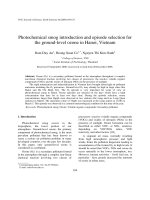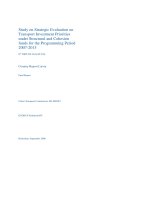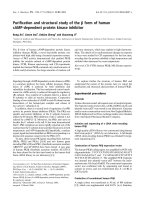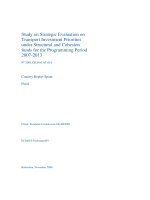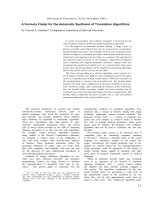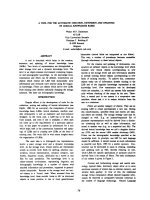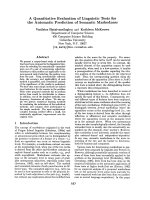experimental and numerical study for the automatic gma welding process
Bạn đang xem bản rút gọn của tài liệu. Xem và tải ngay bản đầy đủ của tài liệu tại đây (2.86 MB, 183 trang )
i
ACKNOWLEDGMENTS
I would like to thank those who helped me during the course of my study at the
Mokpo National University, South Korea. First, I would like to thank specifically
my supervisor, Professor Kim Ill Soo for his scholarships, guidance, critical
feedback, and valuable advice during this study. I would like also to express my
special indebtedness to Professor Park Chang Eun, Professor Yoon Han Yong, Dr.
Jang Kyeung Cheun and Dr. Lee Dong Gill who provided expertise that greatly
enhance this thesis.
I would also like to express a very special thanks to the members in my research
group at the Welding and Automatic Control Laboratory, especially Mr. Kim Hak
Hyoung, Mr. Seo Joo Hwan, Miss. Shim Ji Yeon and Mr. Jeong Jae Won for all
their help on the experiment and valuable discussions in the laboratory.
Finally, on this occasion allow me to express my gratitude and appreciation to my
elder sister, Doan Thi Quynh Nga, my wife Pham Thi Giang Lam, and my bosom
friend Hua Huu Tho for all their support and understanding during the course of
this study.
ii
Experimental and Numerical Study
for the Automatic GMA Welding Process
Doan The Thao
Department of Mechanical Engineering
Graduate School of Mokpo National University
(Supervised by Professor Kim Ill Soo)
<Abstract>
Generally, GMA (Gas Metal Arc) welding process is currently one of the most
popular welding methods. To improve the welded quality and reliability as well
as to increase productivity, the selection of the optimal process parameters for the
robotic GMA welding process has been required as setting welding condition to
archive the desired bead geometry. For this reason, it is need to know the
interrelationship between the process parameters and bead geometry as welding
quality.
On the other hand, the welding deformations in all stages of a welding process for
achieving the required precision of welded structure must be taken into account
and as a result, it is required to predict the welding distortions at the early stages
of welded structure design by using a simulation. Therefore, a FEM (Finite
iii
Element Method) model with a suitable moving heat source, which can accurately
simulate the thermal histories of GMA welding process, needs to be developed.
Furthermore, the determination of trajectory planning and continuous motion of
welding torch without colliding with any obstacles for robotic welding system of
complex structures should be considered. It is better way to build a robotic
welding system using the simulation tools in order to identify some of design and
planning problems at an early stage.
The sequent experiments based on full factorial design have been conducted with
two levels of five process parameters to obtain bead geometry of butt and lab
joint type using a GMA welding process. Four empirical models have been
developed: linear, curvilinear, interaction and a proposed intelligent model.
Regression analysis was employed for optimization of the coefficients of linear,
curvilinear, and interaction model, while GA (Genetic Algorithm) was utilized to
estimate the coefficients of intelligent model. Not only the fitting of these models
were checked and compared by using variance test, but also the prediction on
bead geometry using the developed models were carried out based on the
additional experiments.
The thermal analysis models for automatic finding parameters of a moving heat
source have also been proposed. An algorithm for the combining between GA and
the FEM was obtained and verified based on Goldak’s work and additional
experiments for multi-pass butt and fillet welded joint with dissimilar thickness.
In this algorithm, GA was effectively employed to estimate the parameters of
Goldak’s double ellipsoidal model.
iv
Furthermore, not only the initial kinematic simulation model with six degrees of
freedom for Faraman AM1 welding robot has been developed using CATIA V5
software, but also the forward and inverse kinematic equations also be obtained
by using conventional numerical methods. The output results computed from
simulation model were employed to compare with calculated results from
kinematic equations to validate the simulation one.
v
TABLE OF CONTENTS
Contents Page
ACKNOWLEDGEMENTS i
ABSTRACT ii
TABLE OF CONTENTS v
LIST OF FIGURES ix
LIST OF TABLES xiv
NOMENCLATURE xv
ACRONYMS xix
PUBLICATIONS xxi
CHAPTER 1: INTRODUCTION 1
1.1 MOTIVATION 1
1.2 SCOPE OF THE RESEARCH WORK 5
1.3 THESIS ORGANIZATION 6
CHAPTER 2: LITERATURE SURVEY 9
2.1 INTRODUCTION 9
2.2 FULL FACTORIAL DESIGN AND EMPIRICAL MODELS 10
2.2.1 Full factorial design 10
2.2.2 Linear model 11
2.2.3 Curvilinear model 12
2.2.4 Interaction model 12
2.3 DESIGN OF EXPERIMENTS AND OPTIMIZATION PROCEDURE
13
vi
2.4 GOVERNING EQUATION FOR TRANSIENT HEAT TRANSFER
ANALYSIS 18
2.5 MOVING HEAT SOURCE MODELS 19
2.5.1 Models for moving heat source 19
2.5.2 Heat source and FEM models 23
2.6 CATIA SOFTWARE AND APPLICATIONS 28
2.7 ROBOTICS WELDING SYSTEMS 31
CHAPTER 3: PREDICTION ON TOP-BEAD WIDTH FOR THE BUTT
WELD USING A GENETIC ALGORITHM 35
3.1 INTRODUCTION 35
3.2 EXPERIMENTAL WORK 36
3.3 DEVELOPMENT OF EMPIRICAL MODELS 39
3.3.1 Selection of mathematical model 39
3.3.2 Developed the mathematical model 40
3.3.2.1 Genetic algorithm 40
3.3.2.2 Development of empirical models 43
3.4 RESULTS AND DISCUSSION 47
3.4.1 The verification of the developed models 47
3.4.2 The effects of process parameters 50
3.5 CONCLUSSION 61
CHAPTER 4: PREDICTING BEAD GEOMETRY FOR LAB JOINT
USING AN INTERACTION MODEL 62
4.1 INTRODUCTION 62
4.2 EXPERIMENTAL WORK 63
vii
4.3 DEVELOPMENT OF EMPIRICAL MODELS 64
4.3.1 Bead width 65
4.3.2 Bead height 68
4.4 RESULTS AND DISCUSSION 70
4.4.1 ANOVA analysis for developed models 70
4.4.2 The accurate prediction of models 71
4.4.3 Effects of main process parameters 74
4.4.4 Effects of interaction for process parameters 76
4.5 CONCLUSSION 79
CHAPTER 5: DEVELOPMENT OF NUMERICAL MODEL 80
5.1 INTRODUCTION 80
5.2 DEVELOPMENT OF FEM MODEL USING A GA 80
5.3 VERIFICATION OF THE DEVELOPED GA-FEM MODEL 85
5.3.1 Verification of batch mode model 85
5.3.2 Verification of the GA-FEM model 88
5.4 WELDING CONDITIONS AND DIMENSIONAL DETAILS OF
ADDITIONAL EXPERIMENTS 94
5.5 DEVELOPMENT OF FEM MODEL 97
5.5.1 Assumptions 97
5.5.2 Governing equation 98
5.5.3 Thermal physical properties of material 98
5.5.4 Mesh generation 99
5.6 RESULTS AND DISCUSSION 102
5.7 CONCLUSSION 113
viii
CHAPTER 6: SIMULATION MODEL FOR ROBOTIC WELDING 114
6.1 INTRODUCTION 114
6.2 CATIA SOFTWARE 115
6.3 KINEMATICS 116
6.3.1 D-H (Denavit-Hartenberg) convention 116
6.3.2 Forward kinematics 120
6.3.3 Inverse kinematics 125
6.3.3.1 Solving for θ
1
125
6.3.3.2 Solving for θ
3
128
6.3.3.3 Solving for θ
2
129
6.3.3.4 Solving for θ
4
131
6.3.3.5 Solving for θ
5
132
6.3.3.6 Solving for θ
6
133
6.4 DEVOLOPEMENT OF SIMULATION MODEL 135
6.5 RESULTS AND DISCUSSION 139
6.6 CONCLUSION 142
CHAPTER 7: CONCLUSIONS 143
7.1 CONCLUSIONS 143
7.2 SUGGESTION FOR FUTURE WORK 145
REFERENCES 147
ix
LIST OF FIGURES
Figure Page
2.1 Coordinate system used for the FEM analysis of disc model
according to Krutz and Segerlind [36] 21
2.2 Goldak’s double ellipsoidal heat source model [37] 22
2.3 Structure and interfaces of the system according to Hackel [89] .
34
3.1 Input and output parameters of the GMA welding process 36
3.2 Configuration of butt welding specimen. 38
3.3 Butt welding specimen 38
3.4 Measurement of top-bead width. 39
3.5 Flow chart for the GA [25]. 42
3.6 Comparison on the fitting of three developed models 48
3.7 The accurate prediction of three developed models. 49
3.8 The effect of welding speed on top-bead width 52
3.9 The effect of welding voltage on top-bead width 52
3.10 The effect of arc current on top-bead width 53
3.11 The effect of tip gap on top-bead width 53
3.12 The effect of gas flow rate on top-bead width 54
3.13 Interaction effect of welding voltage and welding speed on top-
bead width 55
3.14 Interaction effect of gas flow rate and welding speed on top-bead
width 55
3.15 Interaction effect of welding speed and tip gap on top-bead width.
56
x
3.16 Interaction effect of welding speed and arc current on top-bead
width 56
3.17 Interaction effect of tip gap and gas flow rate on top-bead width.
57
3.18 Interaction effect of gas flow rate and welding voltage on top-
bead width 57
3.19 Interaction effect of tip gap and welding voltage on top-bead
width 58
3.20 Interaction effect of gas flow rate and arc current on top-bead
width 58
3.21 Interaction effect of tip gap and arc current on top-bead width
59
3.22 Interaction effect of arc current and welding voltage on top-bead
width 59
4.1 Schematic diagram for measurement of bead geometry 64
4.2 Comparison of measured and calculated results for bead width. .
71
4.3 Comparison of measured and calculated results for bead height
71
4.4 Predictable accuracy of the developed models for bead width
73
4.5 Predictable accuracy of the developed models for bead height
74
4.6 Effect of welding voltage on bead geometry 75
4.7 Effect of arc current on bead geometry 75
4.8 Effect of welding speed on bead geometry 76
xi
4.9 Interaction effect of welding voltage and arc current on bead
width 77
4.10 Interaction effect of CTWD and welding angle on bead width
77
4.11 Interaction effect of CTWD and welding angle on bead height
78
5.1 Heat flux distributions at plane y = 0 using (5.1), (5.2), (5.4)
equations. 82
5.2 Heat flux distributions at plane y = 0 using (5.1), (5.2), (5.5),
(5.6) equations 82
5.3 Flow chart for the GA-FEM model. 84
5.4 Comparison with Goldak’s work.
5.4(a) Goldak’s work [37] 86
5.4(b) Results of developed FEM model 86
5.5 Dependence of material properties on temperature [38].
5.5(a) Thermal conductivity factor table 87
5.5(b) Specific heat factor table 87
5.6 2D symmetric FE mesh model 88
5.7 Dimension details and weld bead sequence [51].
5.7(a) Dimension details of plates 89
5.7(b) Weld bead sequence 89
5.8 Temperature distributions from the developed model 92
5.9 Temperature distributions on the left plate [51]. 92
5.10 Temperature distributions on the right plate [51]. 93
5.11 Dimensional details and weld bead sequence.
5.11(a) For the 5 pass butt weld 96
xii
5.11(b) For the 2 pass fillet weld 96
5.12 Thermal physical properties of SM490A material 99
5.13 2D FE mesh generation.
5.13(a) For the 5 pass butt weld 100
5.13(b) For the 2 pass fillet weld 100
5.14 Temperature fields and cross section for the 5 pass butt weld.
5.14(a) Actual cross section of the 5 pass butt weld bead 104
5.14(b) Temperature fields at time t = 2.999s, first pass welding 104
5.14(c) Temperature fields at time t = 531.088s, second pass welding104
5.14(d) Temperature fields at time t = 1068s, third pass welding 104
5.14(e) Temperature fields at time t = 1479s, fourth pass welding 104
5.14(f) Temperature fields at time t = 1788s, fifth pass welding 104
5.15 Temperature fields and cross section for the 2 pass fillet weld.
5.15(a) Actual cross section of the 2 pass fillet weld bead 105
5.15(b) Temperature fields at time t = 3.753s, first pass welding 105
5.15(c) Temperature fields at time t = 834.562s, second pass welding105
5.16 Temperature histories in the weld pools for the 5 pass butt weld.
5.16(a) First pass (Peak temperature = 1711
o
C) 106
5.16(b) Second pass (Peak temperature = 1896
o
C) 106
5.16(c) Third pass (Peak temperature = 2053
o
C) 106
5.16(d) Fourth pass (Peak temperature = 1990
o
C) 107
5.16(e) Fifth pass (Peak temperature = 2078
o
C) 107
5.17 Temperature histories in the weld pools for the 2 pass fillet weld.
5.17(a) First pass (Peak temperature = 2126
o
C) 108
5.17(b) Second pass (Peak temperature = 2044
o
C) 108
xiii
5.18 Temperature histories on the left side plate during 5 pass butt
weld at selected points. 109
5.19 Temperature histories on the right side plate during 5 pass butt
weld at selected points. 109
5.20 Temperature histories during 2 pass fillet weld at selected points
for the back surface 111
5.21 Temperature histories during 2 pass fillet weld at selected points
for the front surface 111
6.1 Internal welding carriage project. 115
6.2 Schematic of the adjacent axes with the appropriately assigned
reference frames for determining the Denavit-Hartenburg
parameters [107]. 117
6.3 Faraman AM1 welding robot 121
6.4 Work envelope dimensions of Faraman AM1 welding robot.121
6.5 D-H convention joint-coordinate diagram 123
6.6 CATIA parts, assembly model and D-H convention joint-
coordinate diagram 136
6.7 CATIA simulation model of the robot 138
6.8 Simulation with Laws icon. 138
6.9 Comparisons on computed distance results of simulation model
and forward kinematic equations 139
6.10 Comparison on angle values of simulation model and inverse
kinematic results.
6.10(a) For
Δθ
1
and
Δθ
2
140
6.10(b) For
Δθ
3
and
Δθ
4
140
6.10(c) For
Δθ
5
and
Δθ
6
141
xiv
LIST OF TABLES
Table Page
3.1 Process parameters and values 37
3.2 GA parameters and values 42
3.3 Expressions were used to check the fitting 46
3.4 Variance test for developed empirical models 47
3.5 Welding condition for the additional experiments 48
3.6 ANOVA analysis using experimental data 51
4.1 Process parameters and values 64
4.2 ANOVA analysis for the model of bead width 67
4.3 ANOVA analysis for the model of bead height 69
4.4 Analysis of variance tests for developed models 70
4.5 Welding condition and the results for the additional
experiments 73
5.1 Weld parameters during welding [51] 90
5.2 Thermal properties of 304 stainless steel materials [52] 90
5.3 Parameters of double ellipsoidal heat source 91
5.4 Comparison of peak temperature value 94
5.5 Weld parameters during welding of two types of weld 95
5.6 Parameters of double ellipsoidal heat source 102
5.7 Peak temperatures (
o
C) for the 5 pass butt weld at selected
points 110
5.8 Peak temperatures (
o
C) for the 2 pass fillet weld at selected
points 112
6.1 Kinematic parameters of Faraman AM1 robot 120
xv
NOMENCLATURES
A Welding angle
A
s
Cross-sectional area of the fusion zone
C CTWD
D Distribution width coefficient
G Gas flow rate
H Bead height
−
H
Measured bead height
I Arc current
M Number of coefficients
N Population size
N
Total
Total number of all i-factor interaction terms
ObjV Objective function
Q Heat generation rate per unit volume
Q(0) Maximum flux at the center of the heat source
Q(r) Surface flux at radius r
Q
B
Body flux
Q
f
Power density distribution for front heat source
Q
r
Power density distribution for rear heat source
Q
S
Surface flux
Q
W
Energy input rate
Q
WB
Heat input due to body flux
Q
WS
Heat input due to surface flux
S Welding speed
T Temperature
xvi
Tg Tip gap
i
T
−
Measured peak temperature
i
^
T
Calculated peak temperature
j
i
Link transformation matrix
V Welding voltage
W Bead width
−
W
Measured bead width
W
T
Top-bead width
T
W
−
Measured top-bead width
X
i
Independent variables
Y Dependent variables
i
Y
−
Measured results
i
^
Y
Calculated results
−
Y
Average value of the measured results
(X
i
, Y
i
, Z
i
) Link-coordinate frames
a Semi-axis of ellipsoid in the x direction
a
i
Link length
b Semi-axis of ellipsoid in the y direction
b
i
Estimate regression coefficients of
i
β
c Semi-axis of ellipsoid in the z direction
c
F
Characteristic radius of heat flux distribution
c
f
Semi-axis of front ellipsoid in the z direction
c
i
Coefficients
xvii
c
p
Specific heat capacity
c
r
Semi-axis of rear ellipsoid in the z direction
d Diameter of welding wire
d
i
Link offset
f
f
Fractional factors of the heat deposited in the front quadrant
f
r
Fractional factors of the heat deposited in the rear quadrant
h Combined heat transfer coefficient
k Thermal conductivity of material
k
i
Coefficients
m Number of factors (variables)
n Number of runs
n
A
Number of axes
n
T
Number of measured peak temperature
p Number of levels
q Heat flux vector
r Radial distance from the center of heat source
t Time
t
s
Load time step
u Number of terms (main and interaction)
(x,
ξ
)
Moving coordinate system attached to the surface heat source
(x, y,
ξ
)
Moving coordinate system attached to the volume heat source
(x, y, z) Fixed coordinate system attached to the volume heat source
xviii
Greek symbol
Δθ
i
Difference of angle values
∇
Grad operator
∇⋅
Divergence operator
α
i
Link twist angle
β
i
Parameters
ε
Emissivity of the surface of the body
ε
i
Experimental error. ε
i
is unobservable and represents all other
factors affecting Y which are not in X
1
, X
2
,…, X
m
η
Arc efficiency
λ
Percentage error
π
Pi constant
θ
i
Joint angle
ρ
Density of the material
τ
Lag factor
xix
ACRONYMS
Acronyms Explanation
2D Two Dimensional
3D Three Dimensional
AI Artificial Intelligence
ANOVA Analysis of Variance
API Application Programming Interface
BPNN Back-Propagation Neural Network
CAA Component Application Architecture
CAD Computer Aided Design
CAE Computer Aided Engineering
CAM Computer Aided Manufacturing
CATIA Computer Aided Three Dimensional Interactive Application
CCD Central Composite Design
CCD Charge-Coupled Device
CRS Controlled Random Search
CTWD Contact-Tip-To-Work Distance
DF Degrees of Freedom
DOE Design Of Experiments
EA Evolutionary Algorithm
EO Evolving Objects
FEM Finite Element Method
FZ Fusion Zone
GA Genetic Algorithm
GAWCEM Genetic Algorithm Welding Current Estimation Model
xx
GAWSEM Genetic Algorithm Welding Strength Estimation Model
GAWVEM Genetic Algorithm Welding Velocity Estimation Model
GLM General Linear Model
GMA Gas Metal Arc
GSM Generative Shape Modeling
GTA Gas Tungsten Arc
GUI Graphical User Interface
HAZ Heat Affected Zone
MIG Metal Inert Gas
MMA Manual Metal Arc
MOKA Methodology and Software Tools Oriented To Knowledge
Based Engineering Applications
MS Mean Square
MSE Mean Square Error
MST Mean Square Total
OLP Off-Line Programming
PLM Product Lifecycle Management
RSM Response Surface Methodology
SA Simulated Annealing
SAON Self-Adaptive Offset Network
SAW Submerged Arc Welding
SMA Shield Metal Arc
SSE Sum of Square Error
SST Sum of Square Total
SWERS Ship Welding Robot System
TIG Tungsten Inert Gas
xxi
PUBLICATIONS
International Journals
1. D.T. Thao and I.S. Kim. An Evaluation Approach for Prediction of
Process Parameters with Genetic Algorithm. Material Science Forum,
Vols. 580-582 (2008), pp 375-378.
2. D.T. Thao, J.W. Jeong, I.S. Kim and J.W.H.J. Kim. Predicting Lab-Joint
Bead Geometry in GMA Welding Process. Archives of Materials Science
and Engineering, Vol. 32, Issue 2 (2008), pp 121-124.
3. D.T. Thao, I.S. Kim, H.H. Kim, J.W. Jeong and B.Y. Kang. Developed
Simulation Model-Kinematics for Robotic Arc Welding. Asian
International Journal of Science and Technology in Production and
Manufacturing, Vol. 1, No. 2 (2008), pp 69-76.
xxii
International Conference and Others.
1. D.T. Thao, I.S. Kim, J.S. Son and J.H. Seo. Developed Multiple Linear
Regression Model using Genetic Algorithm for Predicting Top-Bead
Width in GMA Welding Process. Proceedings of the 2006 Autumn Annual
Meeting of Korean Welding Society (KWS 2006-Autumn), 19th-20th,
October, Pusan, Korea, 2006.
2. 김일수, D.T. Thao, 문채주, 한양주. CIM 기반 소수력발전용
권양기 설계에 관한 연구.
2006 년 대한전기학회 광주
전남지부
추계학술대회
, 12 월 8 일, 2006.
3. D.T. Thao and I.S. Kim. An Evaluation Approach for Prediction of
Process Parameters with Genetic Algorithm. International Welding
Joining Conference-Korea (IWJC), 10th-12th, May, Seoul, Korea, 2007.
4. D.T. Thao, I.S. Kim, I.J Kim, B.Y. Kang, K.C. Chang and D.G. Lee.
Development of Simulation Model for Robotic Welding using Catia
Program. International Symposium on Mechatronics and Automatic
Control-Vietnam (ISMA), 25th-26th, October, Ho Chi Minh city, Vietnam,
2007.
xxiii
5. D.T. Thao, I.S. Kim, H.H. Kim and S.W. Son. A Study about
Development of Welding Heat Input Model using Genetic Algorithm
.
Proceedings of the 2008 Spring Annual Meeting of Korean Welding and
Joining Society (KWJS 2008-Spring), 8th-9th, May, Daejon, Korea, 2008.
6. D.T. Thao, J.W. Jeong, I.S. Kim and J.W.H.J. Kim. Predicting Lab-Joint
Bead Geometry in GMA Welding Process. The 16th International
Scientific Conference on Achievements in Mechanical and Materials
Engineering-Poland (AMME), 22nd-25th, June, Gliwice, Poland, 2008.
7. D.T. Thao, I.S. Kim, H.H. Kim, J.W. Jeong and B.Y. Kang. A Study on
Simulation Model for Robotic Arc Welding. The 9th Global Congress on
Manufacturing & Management-Australia (GCMM), 12th-14th, November,
Gold Coast, Australia, 2008.
1
CHAPTER 1
INTRODUCTION
1.1 MOTIVATION
With capabilities of application to a wide range of metals and thickness, high
production, and adaptable to robotic application, GMA welding is currently one
of the most popular welding methods, especially in a broad range of industrial
environments. In GMA welding, heat source is an arc created and maintained
between a consumable bare wire electrode and the workpiece. The weld is formed
by melting and solidification of the joint edges together with filler metal
transferred from the electrode. A flow of inert gas has been shielded the weld
metal from the surrounding atmosphere. The sequence of heating and cooling
cycle during welding process cause the nonuniform expansion and contraction of
the weld and surrounding base material results in distortion in a welded structure
[40]. There are two ways that are used for reducing distortion of welding
structures. The first way is to employ a work clamp and motion devices to hold
workpieces accurately in position. Another method is to conduct some
experiments to find out the optimal welding sequence [99]. Unfortunately, two
techniques are time consuming and have a high cost. Effective uses of simulation
tools can help to predict the distortions and optimize the welding sequence at an
early stage before the real work begin. In addition, bead geometry in the GMA
welding process as a welding quality is an important factor in determining the
2
mechanical characteristics of the weld [1] which greatly effects on quality of
welding structures.
To achieve the high quality and welding performance, an interrelationship
between bead geometry and welding parameters requires to be developed.
Research on finding out these relationships is not novel. Many efforts have been
done to develop the analytical and numerical models to study these relationships
[1-13]. Kim et al. [1] proposed a method for determining the near-optimal settings
of welding process parameters to obtain the desired weld bead geometry in GMA
welding using a CRS algorithm which is similar to the GA. Raveendra et al. [2]
and Yang et al. [3] employed multiple regression techniques to establish the
empirical models for various arc welding processes. Datta et al. [4] developed
three empirical models for predicting bead volume of submerged arc butt welding.
Also, Gunaraj et al. [5] proposed empirical models for prediction and
optimization of weld bead for the SAW process. Furthermore, Gunaraj et al. [6]
highlighted the use of RSM by designing a central composite rotatable design
matrix to develop empirical models for predicting weld bead quality in SAW for
pipelines.
Recently, some researches have been attempted to use AI techniques to model the
relationships between process parameters and bead geometry [7-11]. Kim et al.
[7] developed an intelligent system for GMA welding process based on factorial
experimental. Li et al. [8] studied the non-linear relationship between the
geometric variables and welding parameters for SAW process using the SAON.
Tarng et al. [9] constructed the relationship between process parameters and the
weld pool geometry for TIG welding process using a BPNN. Lee et al. [10]
